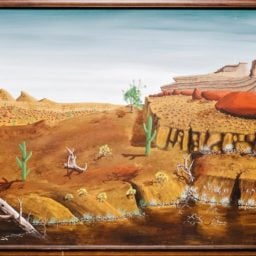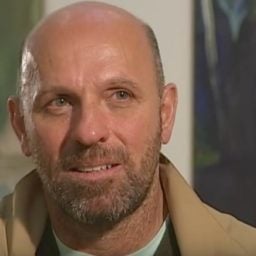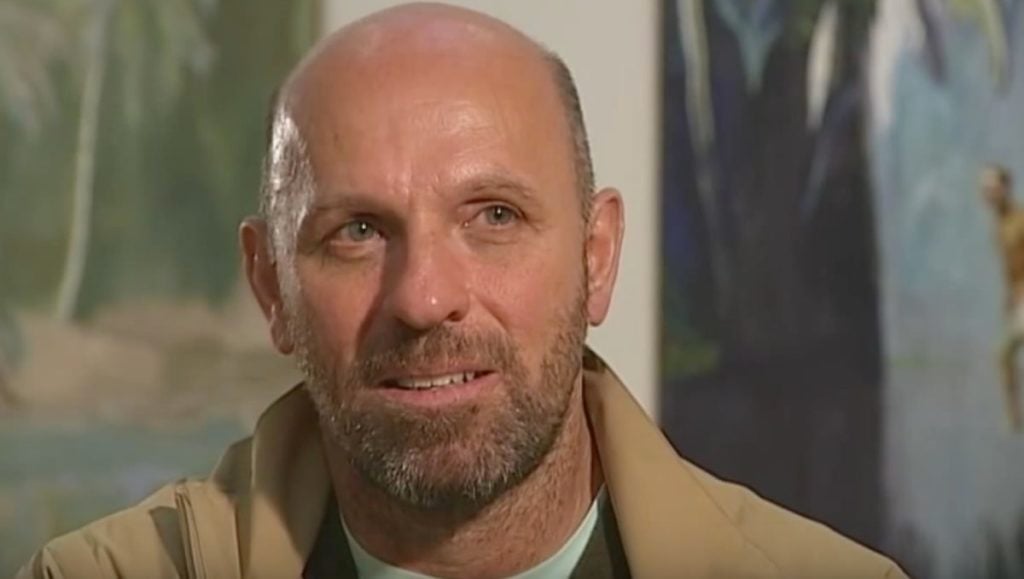

Peter Doig has won the bizarre authentication trial in which he was accused of disavowing a painting that the plaintiffs, art dealer Peter Bartlow and a former corrections officer Robert Fletcher, claimed he had painted as a teen. Bartlow and Fletcher were seeking $7.9 million in damages, but speaking at the Federal District court for Northern Illinois on August 23, Judge Gary Feinerman said Doig “absolutely did not paint the disputed work.”
“I have rarely seen such a flagrant example of unethical conduct in the US courts nor a case that inflicted such needless burdens on a defendant,” said Matthew S. Dontzin, the lawyer representing Doig and Michael Werner Gallery, another defendant in the case, in an email to artnet News. “Artists should be grateful to Peter for having the ethical and financial fortitude to fight tirelessly to ensure that justice prevailed in today’s verdict.”
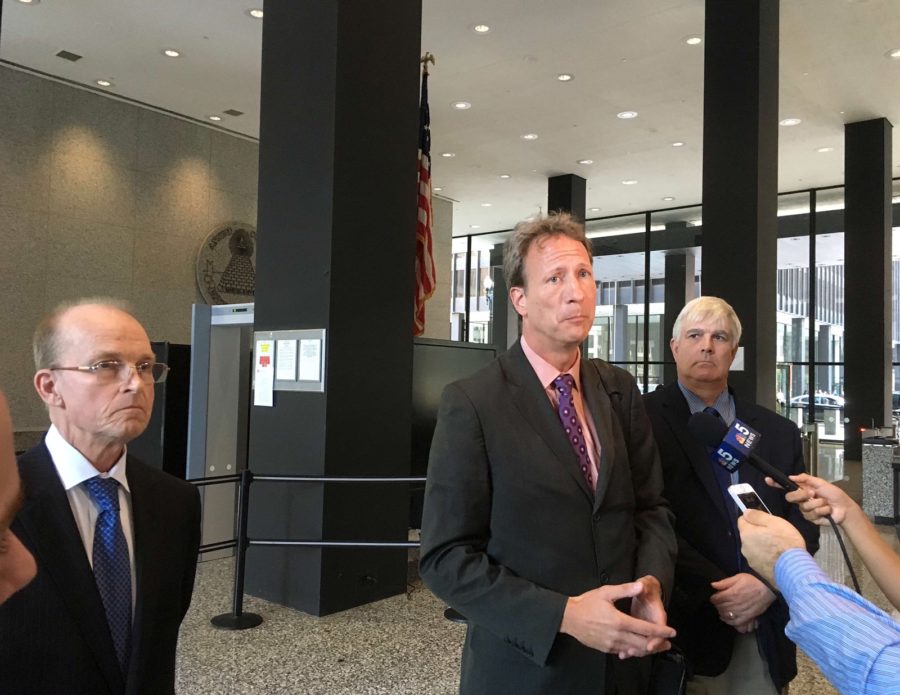
Bartlow, Zieske, and Fletcher. Image: Magdalena Moskalewicz
Doig himself and most of his legal team, which included Dontzin and Tibor Nagy, were conspicuously absent in the courtroom as the interested parties in his case reconvened one week after closing arguments to hear Judge Feinerman’s verdict in the case. Co-plaintiffs, former corrections officer Robert Fletcher and Chicago gallerist Peter Bartlow, were present, as well as their lawyer, William F. Zieske, as the contested painting emerged from a cardboard box and took its place on the tripod where it had stood throughout the weeks-long trial.
“Today’s verdict is the long overdue vindication of what I have said from the beginning four years ago: a young talented artist named Pete Edward Doige painted this work, I did not,” said Doig in a statement. “That the plaintiffs in this case have shamelessly tried to deny another artist his legacy for money is despicable. The deceased artist’s family and my family and friends have suffered mightily. Thankfully, justice prevailed, but it was way too long in coming. That a living artist has to defend the authorship of his own work should never have come to pass.”
Doig’s team was represented in the courtroom by one lawyer, Suyash Agrawal. Dontzin, Nagy, and Doig stood by on speakerphone.
Judge Feinerman broke the silent anticipation by saying that “Most narratives in law and life have gaps. Very few narratives are airtight. This is especially true when considering events from 40 years ago, and all the more so when the events are routine quotidian events of daily life.”
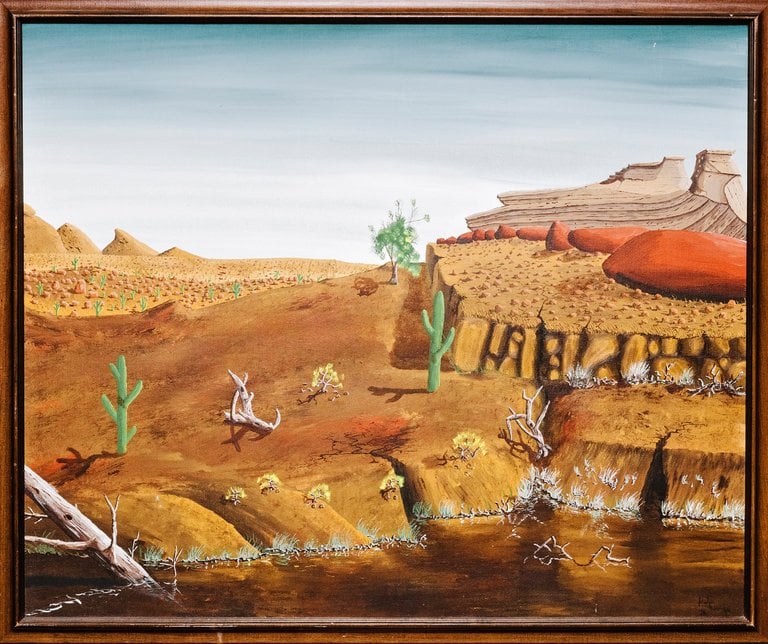
The Peter Doige painting in question depicts a desert landscape. Photo: ARIS Title @ARIS_ArgoGroup via Twitter.
“While most narratives have gaps,” Feinerman went on to say, “and certainly both narratives have gaps, the evidence conclusively demonstrates that despite some gaps, Peter Marryat Doig absolutely did not paint the disputed work.”
Feinerman then reviewed all the details of the case, painstakingly going through the evidence and repeatedly stating that Peter Doig and his mother “testified credibly” about Doig’s whereabouts, employment, education, where they were backed up by “more than ample evidence.”
As for the contradictions between the timeline Doig initially sent to his own gallery, stating that he didn’t go to high school in ’76/’77, Feinerman called this a “hiccup” in the narrative and underlined that this “understandable mistake that does not harm Mr. Doig’s credibility because it was 40 years ago,” citing his own imprecise memories of being a counselor at Camp Ojibwa decades ago. Feinerman took a similar position on Doig’s lack of tax records, pointing out that not many teens even file taxes for part-time employment, much less keep records for decades afterwards.
Saying that glitches in Doig’s statement would have had more significance if it wasn’t for the “unmistakable and unimpeachable evidence” that supported his final timeline, including a letter from the summer of 1977 from Mary Doig to her own mother in Great Britain saying that “Peter phoned from Edmonton.” Reading aloud that “Peter’s hair is long and messy and if you smell his hat, it smells of oil,” Feinerman emphasized how Mary would have had no conceivable motive to invent these details, which corroborated her son’s timeline about where he was when the painting was made.
In describing the evidence that Peter Doige “almost certainly painted the work,” Judge Feinerman described the deceased man’s sister’s testimony as “the third cherry on top of the sundae.”
There were in fact many such cherries, but here are a few: Ernie Adams, the art teacher at the Thunder Bay Correctional Center, had identified Peter Doige as the person who made the painting, testimony Feinerman said he found “especially credible” in part because Adams would have been incentivized to claim he had started Doig’s career. The signature on the painting, besides bearing Doige’s name, also looked like Doige’s other signatures. Feinerman said, “You don’t need graphologists to see the similarities between the signature on the work and two of Peter Doige’s signatures.” Furthermore, Peter Doige’s court records were found at Thunder Bay Courthouse, and Doige would have been 21 when the painting was made, exactly the age Fletcher himself said the painter was.
The judge ruled against the plaintiffs on both counts, ruling that the painting wasn’t by Doig, and that this “unjustified interference” in the painting’s sale at auction was, in fact, justified. Underlining the fact that Doig’s representatives had threatened suit only if the painting was sold “as a work by Mr. Doig,” Feinerman stated that “An artist is well within his rights to ensure that works he did not create are not sold under his name.”
Addressing the vexing issue of burden of proof, Feinerman said that in fact Illinois courts hadn’t been entirely clear in cases like this but that, “In the end it doesn’t matter; the plaintiffs didn’t meet their burden, and the defendants met the burden not just by preponderance of evidence but by clear and convincing evidence.”
“Peter and his family have endured an untold amount of stress and public scrutiny as a result of this senseless lawsuit,” said Gordon VeneKlasen, co-owner of Michael Werner Gallery in a statement. “The court has ruled in his favor, although we are deeply disappointed that it has taken so long to do so. It is our hope that this verdict will have at least one good outcome—that artists maintain the unfettered right to authenticate their own work.”
Speaking after the verdict, Bartlow maintained that “the truth will come out sometime in the future that Mr. Doig painted the painting.” Fletcher, for his part, reaffirmed his personal affection for the painting no matter who made it, and observed earnestly that he had “never known a judge as fair as Judge Feinerman.” Neither man would specify their plans for the painting itself, which they had agreed to collect from the court the following day.
Follow Artnet News on Facebook:
Want to stay ahead of the art world? Subscribe to our newsletter to get the breaking news, eye-opening interviews, and incisive critical takes that drive the conversation forward.
